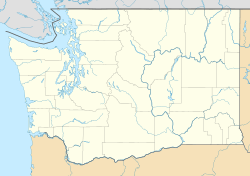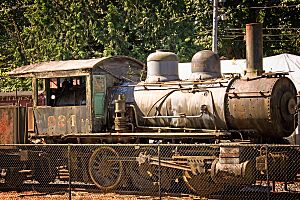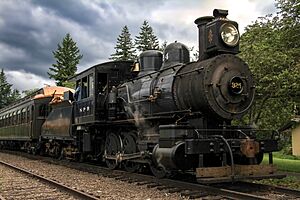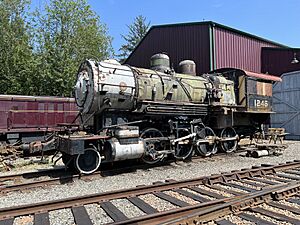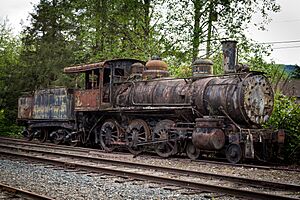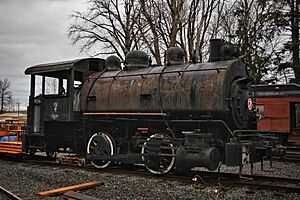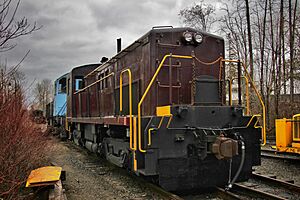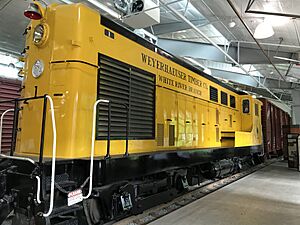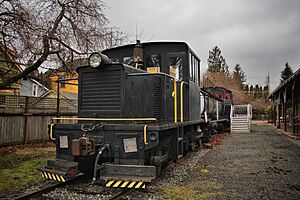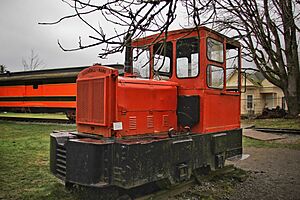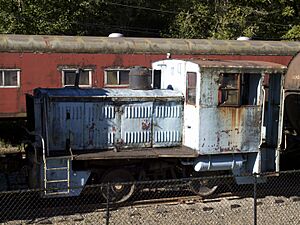Northwest Railway Museum facts for kids
Quick facts for kids |
|
|
Snoqualmie Depot
|
|
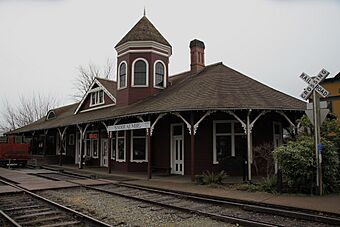
Snoqualmie Depot
|
|
| Location | 38625 S.E. King St. Snoqualmie, Washington |
|---|---|
| Area | less than one acre |
| Built | 1890 |
| Built by | Seattle, Lake Shore and Eastern Railway |
| Architectural style | Victorian |
| NRHP reference No. | 74001963 |
| Added to NRHP | July 24, 1974 |
The Northwest Railway Museum (NRM) is a cool place in Snoqualmie, Washington, where you can learn all about trains! It's like a big playground for train lovers. The museum has a special old train line, a historic train station, a display hall, a library, and a place to take care of its collection. Over 130,000 people visit every year to see and experience railway history.
The museum's heritage railway uses 5.5 miles of track first built in 1889. This track was part of a plan to build a railway over Snoqualmie Pass to Walla Walla, Washington. It was built by the Seattle, Lake Shore and Eastern Railway (SLS&E). This company was Seattle's way of competing with the Northern Pacific Railway, which chose Tacoma, Washington as its main stop. The Northern Pacific later bought the SLS&E in 1901.
Contents
Snoqualmie Depot: A Historic Train Station
The Snoqualmie Depot was built in 1890 by the Seattle, Lake Shore, & Eastern Railway. This unique building had many jobs! It was mainly the main entrance for people visiting this early vacation spot. It also helped local businesses send their products to markets in Seattle.
Because it needed to be both a freight (cargo) and passenger station in a rural area, it had a special design. It also had fancy decorations to welcome vacationers from Seattle. Visitors came to enjoy Snoqualmie Falls and other outdoor fun in the area.
The station is a large wooden building, about 125 feet long and 50 feet wide. It has wide eaves (the part of the roof that hangs over the walls) that are about 9 feet wide. A special bay window was where the telegraph operator worked. The rounded north end of the building is a unique part of its design. Wooden pillars and decorative braces support the eaves.
The Snoqualmie Depot is so important that it's listed on the National Register of Historic Places. This means it's a special building that needs to be protected!
Discover the Northwest Railway Museum
The Northwest Railway Museum started in 1957 as the Puget Sound Railway Historical Association. In 1999, it changed its name to what it is today. The museum's main goal is to show everyone how important railroads were in building the Pacific Northwest. They want you to feel the excitement of a real, working railroad!
The museum has many different train cars and locomotives. These show how the railway network grew in Washington from the 1880s all the way to the 1990s. One special item is the Messenger of Peace Chapel Car, which is also on the National Register of Historic Places. The museum also has a huge library with over 3,000 books and old documents. These focus on the history of railroads in the Northwest and how trains are built and work.
Amazing Train Collection
The museum has a fantastic collection of trains! Let's look at some of the cool locomotives you can find there.
Steam Locomotives: The Power of Steam
Steam locomotives are old-fashioned trains that use steam to move. They are very powerful and were a big part of history!
| Locomotive | Type | Status | Notes | Image |
|---|---|---|---|---|
| Northern Pacific 924 | 0-6-0 Switcher | Operational | Built in 1899. This engine was restored in 2020 and sometimes takes people on special train rides! | |
| Great Northern 1246 | 2-8-0 | Static | Built in 1907. It was on display at a zoo for many years before coming to the museum. | |
| Canadian Colleries 14 | 4-6-0 | Unrestored | Built in 1898. The museum bought it in 1960. | |
| United States Plywood Corporation 11 | Logging Mallet 2-6-6-2 | Cosmetically restored | Built in 1926. It ran trains until 1990 and was made to look nice again in 2005. | |
| Olympic Portland Cement Company 7 | 0-4-0T | Static | Built in 1918. It worked for the Navy and then for cement companies. It came to the museum in 2017. |
Diesel-Electric Locomotives: Modern Power
Diesel-electric locomotives use a diesel engine to generate electricity, which then powers motors that turn the wheels.
| Locomotive | Type | Status | Notes | Image |
|---|---|---|---|---|
| Snoqualmie Valley Railroad 4012 | B-L-H RS-4-TC | Operational | Built in 1954 for the US Army. The museum bought it in 2001. | |
| Snoqualmie Valley Railroad 4024 | B-L-H RS-4-TC | Operational | Built in 1954 for the US Army. This is often the main diesel engine used for rides on the Snoqualmie Valley Railroad. | |
| Weyerhaeuser Timber Company 1 | Fairbanks-Morse H12-44 | Static; Operable | Built in 1951. It was bought in 1987 and made to look like new. | |
| Northern Pacific 125 | ALCo. HH660 | Under restoration | Built in 1940. This is the oldest surviving diesel engine from the Northern Pacific railway! | |
| United States Navy 7320 | GE 45-ton switcher | Static | Built in 1941. It's on display at the Snoqualmie Depot and is known as "Cecil the Diesel Mascot." |
Gasoline-Mechanical Locomotives: Smaller Engines
These locomotives use a gasoline engine, similar to a car, to power the wheels. They are usually smaller than steam or diesel-electric trains.
| Locomotive | Type | Status | Notes | Image |
|---|---|---|---|---|
| J. H. Baxter Company 6-C | Whitcomb MO12 | Static | Built in 1925. It was restored in 2000 and is on display at the Snoqualmie Depot. | |
| St. Regis Paper Company 463 | Plymouth ML-6 | Static | Built in 1943. It was given to the museum in 1977. |
Passenger Cars: Ride in Style
The museum has 18 passenger cars from different time periods, built between 1881 and 1998. Many of these cars were made by famous companies like Barney and Smith, St. Louis Car Company, or Pullman. You can even ride in some of these antique coaches, which date back to 1915 or earlier, on the Snoqualmie Valley Railroad!
Other Railway Equipment
Besides locomotives and passenger cars, the museum also owns 39 other pieces of railway equipment. These include freight cars, industrial equipment, and tools used to maintain the tracks. They show how different parts of the railway system worked in the Northwest.
The Snoqualmie Valley Railroad: Take a Train Ride!
The Northwest Railway Museum runs a special old-fashioned train line called the Snoqualmie Valley Railroad. This 5-mile route lets you take a fun train ride on antique coaches. It's like stepping back in time!
Trains usually run on Saturdays, or both Saturday and Sunday, depending on the time of year. They also have special trains for groups or events. Over 60,000 people ride the train every year! The railroad hosts exciting events like the "Day Out with Thomas" every July, where kids can meet Thomas the Tank Engine. They also have Christmas and Halloween trains, wine tasting trips, and special educational tours.
Railway History Center: Where Trains Get Fixed
In 2006, the museum opened its new Conservation and Restoration Center (CRC). This is a huge workshop where they fix and restore the museum's trains, including locomotives, passenger cars, and freight cars. It's 8,200 square feet and has special pits for inspecting the trains from underneath.
The CRC has all the tools needed for carpentry and machining. This means the museum can even make new parts for old trains that haven't been made since the 1960s! It's a vital place for keeping these historic trains running and looking great.
See also
- List of heritage railroads in the United States


